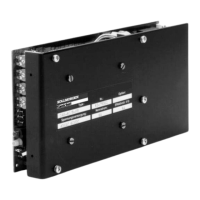III.3 Options
III.3.1 1:1 - control
You can change the speed controller over to current control by closing the solder link LB 1:1.
The proportional section of the amplification is set to 1 in this case, the integral section is
bridged and the tacho signal is switched off internally.
This affects both setpoint inputs
III.3.2 IxR - control
To convert to armature voltage control (without a tachometer) with IxR compensation, first
of all two solder links IxR/TA must be soldered into the position IxR(standard setting: TA).
Only input 1 is available as a setpoint input. The unloaded speed can be set on P1 for a given
setpoint voltage. A setpoint voltage of 10V produces an armature voltage of 40V with P1 on the
right stop.
Afterwards, theIxRpositive feedback can be adjusted at a setpoint = 0V by turning P2 (IN2)
to the right up to the threshold of oscillation – with the motor cold.
The range of adjustment of P2 is from about 0 W up to about 5 W armature resistance.
III.3.3 Option -24V-, external 24V auxiliary voltage
As delivered, the auxiliary supply is fed from the DC-link circuit. If Option -24V- is activated in
the transistor controller, then you can run the auxiliary supply from an external 24V DC source.
The supply is then provided via pin 16d or terminal 14 against -GND
Advantages :
– BTB signal is available independently of the main power supply
– Fault signals remain stored in the transistor controller, even when the
main supply is switched off.
– You can supply the DC-link from a very reduced voltage, allowing for
the control loop stability. This can be useful, for example during
setting up
Disadvantage :
Additional power supply needed
The switch-on threshold of the transistor controller is always 18V, so that 24V-battery
operation is also possible without the 24V option.
Chapter III Functions and Options Page III - 7
Kollmorgen 12.99 Series 04S
In order to use this option, the solder links Ucc / 24V must be changed over to
24V (standard setting : Ucc).
When the back-panel p.c.b. F03SMB is used, the solder link -15V / 24V (see
III.3.4) must be changed over to 24V.

